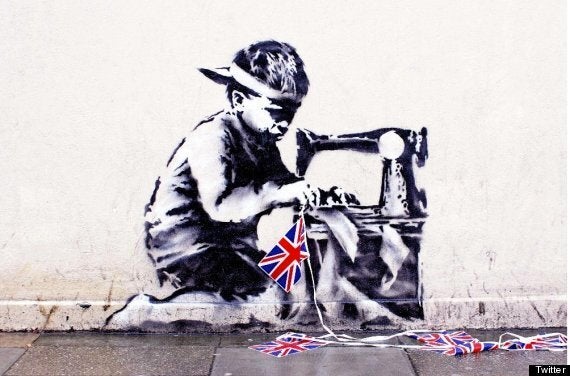The Banksy mural, removed secretly from the wall of a Poundland in Wood Green, has been sold at a secret auction in London to a mystery buyer, to the dismay of local campaigners.
The auctioneers had received three bids of more than £750,000, the London-based dealer Robin Barton, who was representing the restored mural’s owners, said in an email to Bloomberg.
The 2012 work 'Slave Labour, depicting a child in a sweatshop sewing Union Jack bunting, was hacked off the wall of the Poundland, and appeared at Fine Art Auctions in Miami, to wave of protests from Haringey Council, Lynne Featherstone MP and thousands on social media.

The original artwork on the wall outside Wood Green Poundland
Local councillor Alan Strickland had campaigned hard to have the Banksy returned to Wood Green, writing to the government, the owners and the arts council. But the police insist no illegal action has taken place.
It was sold at a private, members-only event at the London Film Museum in Covent Garden.
Haringey TUC secretary Keith Flett told HuffPostUK: "The condition of the ‘Slave Labour’ Banksy shown by the BBC on Sunday evening looks surprisingly pristine for a work that was chiselled off a concrete wall earlier this year. It may well have been reconfigured or reconstructed in some way
"Street art is ephemeral and this appears to be a case of all that is solid melts into air, or all is not quite what it seems.
"Even so the reality is that the owners of the Poundland shop could easily have left the Banksy where it was.
"There is another work by the artist on the wall of a shop in Tottenham not a mile away that remains quite undisturbed by profiteers, and enjoyed by the local community for whom it was intended, to this day."
Sincura's Tony Baxter said in a statement: "The Sincura Group do not condone any acts of wanton vandalism or other illegal activity, however after carrying out extensive due diligence with regard the works provenance and ownership we are entirely satisfied that the mural was legally salvaged and that its current owners and its representative are acting in good faith by consigning the piece to us to act as the centrepiece of our forthcoming art show 'Banksy at the Flower Cellars'.
"We welcome the opportunity to display this controversial work, that since its removal has undergone extensive restoration and are proud that our event will be the first and only time that it will be shown in the United Kingdom before being returned to the United States where it will form an integral part of an important private collection of Banksy street works.
"It is only through The Sincura Group’s unique network that this coup was made possible, everyone was trying to find the true story of the pieces whereabouts and we were the only company to do so. The showing of this piece was the culmination of months of hard work and we simply wish to display it in again its home city before it disappears forever.
"It should be noted that both Scotland Yard and the FBI have issued statements that there is no evidence of criminality involved in the removal of this illegally painted mural and therefore no case to answer. The Sincura Group are making no financial gain from displaying this piece of art."
The freeholder of the building where the piece was painted is Wood Green Investments, a property firm owned by Essex-based businessmen Robert Davies, 60, and Leslie Gilbert, 49.
Speaking to The Sunday Times, the pair refused to confirm or deny whether they were involved in removing the work or even whether they owned the building.
“We’re businessmen, so our primary concern is making money, and I can’t see the benefit for us of setting the record straight about this at the moment,” said Gilbert.
Turner Prize winning artist Grayson Perry said the work had been "destroyed" when it was removed from the wall of the Poundland.
Speaking at an event to celebrate 100 years of conservation at Historic Royal Palaces, Perry said: "The most interesting thing about it for me was that Banksy said the minute they dug it off the wall it wasn't a Banksy any more.
"The very fact that they were trying to preserve it actually destroyed it. And that's an interesting dilemma."